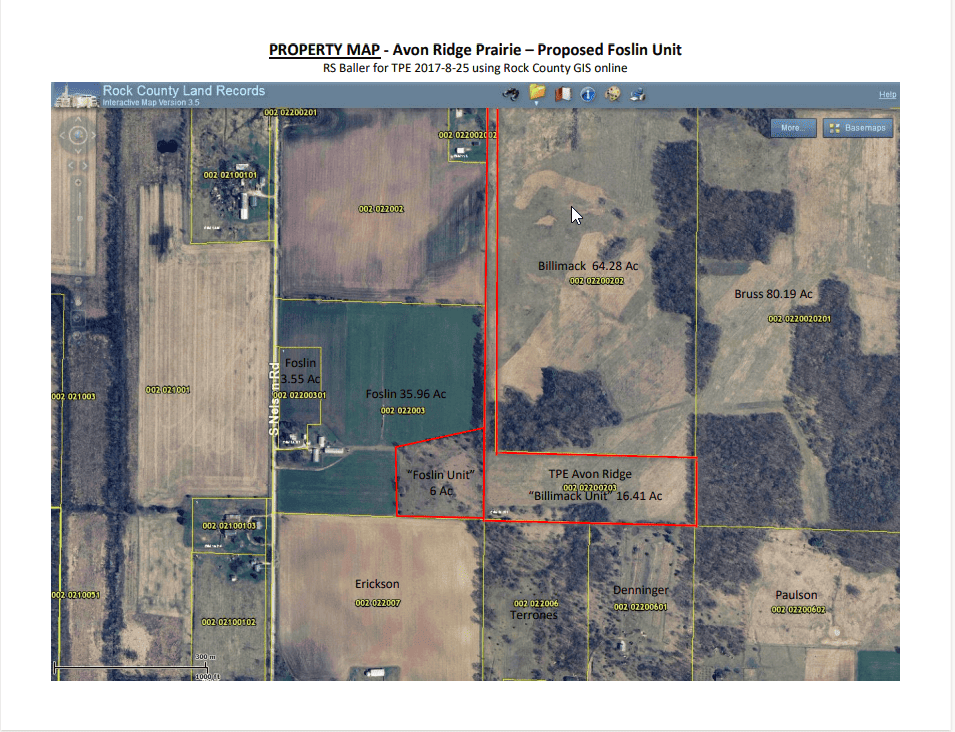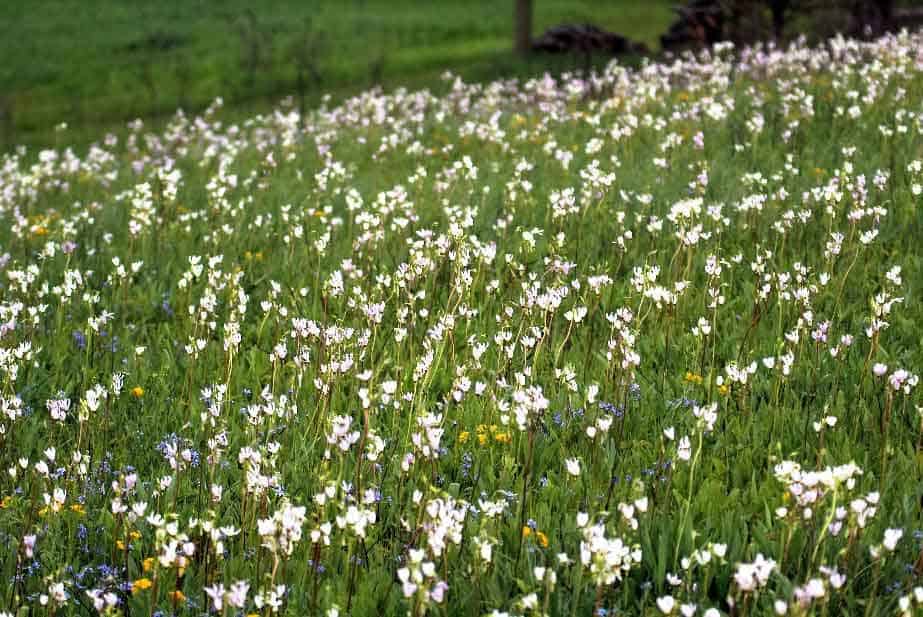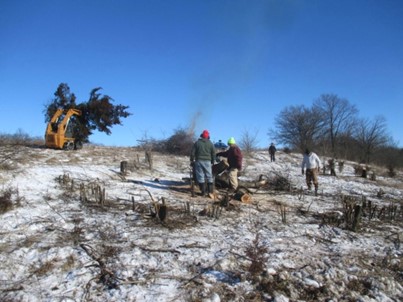
Photo credit: Jerry Newman
Avon Ridge
Avon Ridge is a 16.5 acre parcel purchased by The Prairie Enthusiasts in 2015, and features hundreds of an abundance of rare flowers.
Compass plant, prairie sunflower, and Carolina rose are just some plants commonly found on this scenic spot. This location has a panoramic view southwest over the valley of Sugar River into Illinois. The ridge is part of a complex of mostly riverine grasslands and floodplain forest known as Avon Bottoms.
This property is considered difficult to hike; there are no trails and it is quite a long walk from the parking area to the prairie.
The chapter added 5.9 acres to Avon Ridge with the purchase in 2020 of Foslin Bluff, creating a contiguous 22.4-acre site that is open to the public for hiking, birding and hunting (in season). Both the addition and the original 16.5-acre parcel were purchased with funds from the Knowles-Nelson Stewardship Fund of the Wisconsin DNR.
ACCESS & DIRECTIONS
Visitors should park in the small gravel parking lot off Beloit-Newark Road, a half-mile east of Nelson Road, in the Rock County town of Avon, which is west of Beloit and southeast of Brodhead. Take Highway 81 out of Brodhead a few miles and turn south on Nelson Road, then east on Beloit-Newark. The nearest fire number is 15347 W. Beloit-Newark Road for our neighbor to the west. From the parking lot walk south along the fence line, up the hill and over the ridge to the south-facing one-acre prairie. Foslin Bluff is the extension to the west. The original one-acre remnant is over the ridge. To the east is planted prairie, in a 10-year CRP federal contract we inherited from the previous owner. Access is limited to foot traffic only. Camping, picnics, ATVs and horseback riding are not allowed.
Google Map

Natural History

Photo credit: Jerry Newman
Avon Ridge is a composite of our one-acre, never plowed and never grazed dry hill prairie, plus unplowed ground to the south and west that is privately-owned but contains similar native grasses and uncommon forbs. The ridge is capped with limestone, and underlain by sandstone that has eroded into sloping side hills. Limestone is a hard rock that resists erosion. Sandstone is a softer rock. The ridge is part of a larger landscape known as Avon Bottoms, the lowland along the Sugar River that stretches from Green into Rock County and south into Illinois. Avon Bottoms is comprised of thousands of acres of state owned and leased land.
Fishing, hunting, trapping, birding and canoeing are popular sports in Avon, which is the name of a small unincorporated village and the name of the Rock County township. The principal habitat here is floodplain forest with some wet-mesic prairie, bur oak savanna and old fallow cropland.
The Avon Bottoms Wildlife Area comprises 2,835 acres in the floodplain of the meandering Sugar River bottoms with numerous sloughs and old ox-bows. The lowland hardwood forest contains swamp white oaks, silver maples, black willow, shagbark hickory, hackberry, green ash, cottonwood, bitternut hickory, bur oaks, basswood and sycamore trees.
There are two Wisconsin State Natural Areas embedded in Avon Bottoms: 40-acre Swenson Wet Prairie SNA and 168-acre Avon Bottoms SNA. Avon Bottoms has been declared a Wisconsin Important Bird Area for its breeding populations of the cerulean and yellow-throated warblers, Acadian flycatcher and yellow-crowned night-heron.
Volunteers

Photo credit: Jerry Newman
Work crews from Prairie Bluff Chapter removed most of the trees and brush from the western portion of the remnant prairie during the winter of 2015-16. Sawyers took out cedars, mulberries, cherries, apples, sumac and buckthorn, and then Nick Faessler hauled them to the burn pile with a skid steer. The chapter conducts periodic weed patrols in spring and summer; we collect seed in summer and fall.
Volunteers took out 531 feet of old fence line, woven wire and three tangled and buried strands of barbed wire, between Avon and Foslin. We cleared out dead trees and brush to get at the wire, which was sold to a recycler.
Long ago Foslin Bluff was incorporated into the burn regime at Avon Ridge when Nathan Gingerich was managing Foslin for Applied Ecological Services. He alerted us to a spring burn there, and since then we have been burning small units to the east – part remnant, part CRP grassland – in a rotation that may take a few more years. Next 2020 tasks: TPE signs, remove stumps from access lane, crown vetch, the sumac clone and dumpsite at Foslin. There have been no burns at Avon since fall of 2017 due to limited access through wet area.
Usage Policies
Allowed:
- Hiking
- Birding
- Wildlife Photography
- Hunting
Not Allowed:
- Use of Motorized Vehicles or Bikes
- Camping
- Picnics
- Horseback Riding
Ownership History
Prairie Bluffer and past president Rob Baller first visited this site in the 1980s, with a neighbor Brad Paulson. The chapter was interested in purchasing the remnant prairie land since the chapter’s beginnings around 1987. The property consisted of parcels with three different owners. At that time, the land was sold to an Illinois couple and enrolled in CRP. Again in 2004 the chapter attempted to raise money to buy some of the prairie, but the agreement fell apart. In 2014, chapter members noticed the land was once more for sale. This time our efforts were successful, and we purchased an acre of remnant prairie, a buffer in CRP and access, with a zoning change approved by Avon township.
Visits to Avon Ridge by prairie enthusiasts to view these blooming plants kept the property on our radar for decades until we were able to apply for the stewardship funds and raise the other half of the purchase price from our generous membership.
Avon Ridge was purchased with matching dollars from the Wisconsin Nelson-Knowles Stewardship Fund, so it is open to the public for hiking, hunting, birding and wildlife photography. Access is limited to foot traffic only. Camping, picnics and horseback riding are not allowed.
Management
Next to our one-acre remnant prairie is 14 acres of grasslands that is enrolled in the federal set-aside Conservation Reserve Program. This provides additional habitat for grassland birds. Our management of the prairie and planted grasslands will most likely include prescribed fire. A troublesome invasive plant, crown vetch, is present in a small area of both the CRP and prairie, but the entire property is remarkably free of weeds and brush.
